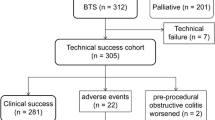Abstract
Background and aims
Self-expandable metallic stents (SEMS) can be used to treat malignant colorectal obstruction (MCO). Guidewire insertion to the proximal site of MCO is the most important step for SEMS placement. However, some patients cannot undergo guidewire insertion because of total obstruction or location at anatomically challenging areas. We report a guidewire insertion technique using an ultrathin endoscope (UTE) in patients with MCO in whom conventional SEMS insertion failed.
Methods
This study was a retrospective cohort study conducted at three academic centers in Korea. The medical records of 956 consecutive patients who underwent SEMS placement during 2012–2021 were analyzed. After failing guidewire insertion using a colonoscope, a UTE was inserted. Guidewire insertion was done through the working channel of the UTE. Following guidewire insertion, the endoscope was removed from the patient. While removing the endoscope, the guidewire was advanced to be located at the originally inserted site. Then, the colonoscope was inserted over the guidewire, and SEMS was replaced.
Results
Conventional SEMS insertion failed in 75 patients. Of these, guidewire insertion using a UTE was tried in 59 patients. The rate of technical success was 91.5% (54/59). Considering all patients, the overall technical success rate of SEMS placement was 97.8% (935/956). This technique increased the technical success rate by 5.6% among the total cohort.
Conclusions
The UTE facilitated guidewire insertion and enhanced the overall success rate for SEMS placement. In addition, this technique can be used as a rescue method when guidewire insertion fails using a colonoscope.






Similar content being viewed by others
References
Arezzo A, Passera R, Lo Secco G et al (2017) Stent as bridge to surgery for left-sided malignant colonic obstruction reduces adverse events and stoma rate compared with emergency surgery: results of a systematic review and meta-analysis of randomized controlled trials. Gastrointest Endosc 86:416–426
van Hooft JE, Veld JV, Arnold D et al (2020) Self-expandable metal stents for obstructing colonic and extracolonic cancer: European Society of Gastrointestinal Endoscopy (ESGE) guideline-update 2020. Endoscopy 52:389–407
Faraz S, Salem SB, Schattner M et al (2018) Predictors of clinical outcome of colonic stents in patients with malignant large-bowel obstruction because of extracolonic malignancy. Gastrointest Endosc 87:1310–1317
Kim SH, Jang SH, Jeon HJ et al (2022) Colonic stenting as a bridge to surgery for obstructive colon cancer: is it safe in the long term? Surg Endosc 36:4392–4400
Cheung DY, Kim JY, Hong SP et al (2012) Outcome and safety of self-expandable metallic stents for malignant colon obstruction: a Korean multicenter randomized prospective study. Surg Endosc 26:3106–3113
Lee YJ, Yoon JY, Park JJ et al (2018) Clinical outcomes and factors related to colonic perforations in patients receiving self-expandable metal stent insertion for malignant colorectal obstruction. Gastrointest Endosc 87:1548-1557.e1
Han B, Hong JY, Myung E et al (2021) Predictors of clinical outcomes of self-expandable metal stent treatment for malignant colorectal obstruction: a Honam Association for the Study of Intestinal Disease (HASID) multicenter study. Medicine (Baltimore) 100:e26616
Zhu Z, Li B, Liao W et al (2020) Novel predictive nomogram for identifying difficult guidewire insertion in patients with malignant colorectal obstruction and sphincterotome-assisted guidewire insertion for improving the success rate of self-expandable metal stent insertion. Front Oncol 10:637
Armstrong EM, Fox BM (2007) Assistance of colorectal stent insertion by sphincterotome. Dis Colon Rectum 50:399–400
Aydinli M, Koruk I, Dag MS et al (2012) Ultrathin endoscopy for gastrointestinal strictures. Dig Endosc 24:150–153
Kim JI, Kim JS, Kim BW et al (2013) Ultrathin endoscope-assisted method for the management of upper gastrointestinal obstruction to avoid technical failure. Clin Endosc 46:373–378
Park SW, Lee H, Park JC et al (2014) Ultrathin endoscope-assisted self-expandable metallic stent placement following initial unsuccessful attempt in malignant upper gastrointestinal obstruction. Dig Endosc 26:200–207
Yuan X, Zhang Z, Gao H et al (2021) Colorectal stent placement assisted by a slim gastroscope: technique and outcomes. Surg Endosc 35:2398–2402
Iboshi Y, Sumida Y, Ihara E et al (2022) Over-the-catheter endoscope replacement for stenting in patients with inaccessible malignant colonic obstruction with coexisting peritoneal carcinomatosis. Dig Endosc 34:1481–1490
Yoon JY, Jung YS, Hong SP et al (2011) Outcomes of secondary stent-in-stent self-expandable metal stent insertion for malignant colorectal obstruction. Gastrointest Endosc 74:625–633
Lamazza A, Fiori E, Schillaci A et al (2018) Proper placement of colorectal self-expandable metal stents with the help of a thin colonoscope-a video vignette. Colorectal Dis 20:356–357
Minoda Y, Ogino H, Sumida Y et al (2022) Is a small-caliber or large-caliber endoscope more suitable for colonic self-expandable metallic stent placement? A randomized controlled study. Therap Adv Gastroenterol 15:17562848211065332
Acknowledgements
This research was supported by a grant of the National Research Foundation of Korea (NRF) grant funded by the Korea government (MSIT) (grant number: NRF-2021R1G1A1094049), Republic of Korea.
Author information
Authors and Affiliations
Corresponding authors
Ethics declarations
Disclosures
Drs Tae-Geun Gweon, Chul-Hyun Lim, MD, Jinsu Kim, Dong Hoon Kang, Bo In Lee, and Young-Seok Cho have no conflict of interest or financial ties to disclose.
Additional information
Publisher's Note
Springer Nature remains neutral with regard to jurisdictional claims in published maps and institutional affiliations.
Rights and permissions
Springer Nature or its licensor (e.g. a society or other partner) holds exclusive rights to this article under a publishing agreement with the author(s) or other rightsholder(s); author self-archiving of the accepted manuscript version of this article is solely governed by the terms of such publishing agreement and applicable law.
About this article
Cite this article
Gweon, TG., Lim, CH., Kim, J. et al. Rescue technique for self-expandable metallic stent placement using ultrathin endoscope after failure of the conventional method in patients with malignant colon obstruction: a multicenter retrospective study. Surg Endosc 37, 7600–7607 (2023). https://doi.org/10.1007/s00464-023-10233-4
Received:
Accepted:
Published:
Issue Date:
DOI: https://doi.org/10.1007/s00464-023-10233-4




